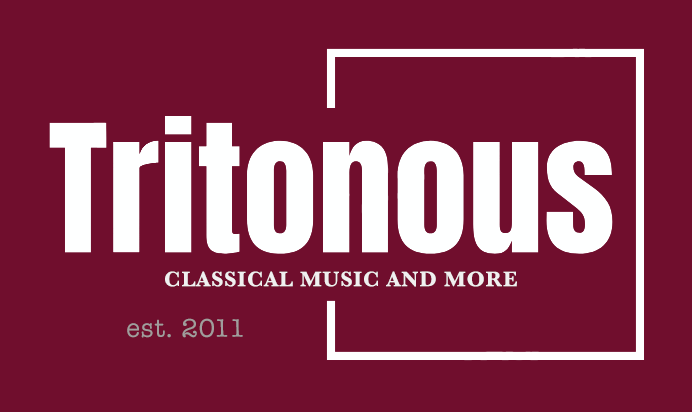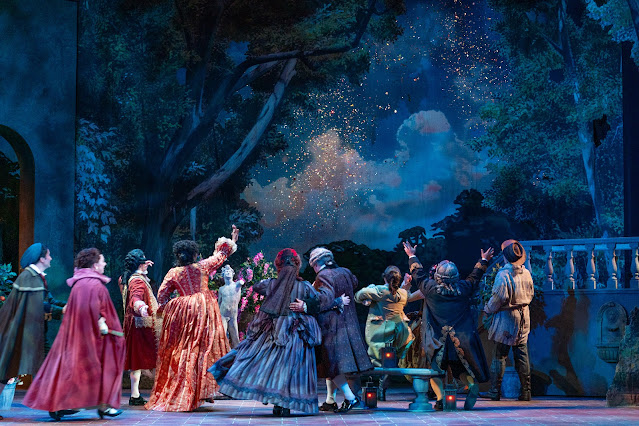 |
| Mozart: Le Nozze di Figaro – Sarasota Opera, 2025 – (Photo: Robert Millington for Sarasota Opera) |
Mozart: Le nozze di Figaro, Verdi: Stiffelio, Rossini: Il barbiere di Siviglia, Mascagni: Cavalleria Rusticana, Leoncavallo: Pagliacci: Sarasota Opera; Sarasota Opera House, Sarasota, Florida
Reviewed by Robert J Carreras, 25-29 March 2025
In our latest Letter from Florida, Robert J Carreras enjoys Sarasota Opera’s 2025 Winter Festival and considers what next for this enterprising company and its quirkily diminutive performance space
What’s next for Sarasota Opera? In recent years, this company seems to have covered all the proverbial operatic bases, advancing from a specialized regional outfit to something like a full-throated and fully invested international opera theatre. Sarasota Opera defies the typical classification of regional company as it has come to be known in the United States, existing more like a top-tier company homed in a quirkily diminutive performance space.
Of late, Sarasota’s performers are more well-rounded, with exciting voices the rule. The stage direction is more concentrated, more diffusely assumed across even supers, and more topically informed. The music-making has kept pace, with visiting conductors adding spicy stylistic touches to already stellar orchestra playing. What’s next?
Wolfgang Amadeus Mozart is the answer to that question for many opera companies. Three of Mozart’s operas take up spots in the top ten most performed operas in the world since the millennium according to OPERABASE. Le nozze di Figaro, sixth on that count, is in repertory for Sarasota’s 2025 Winter Festival.
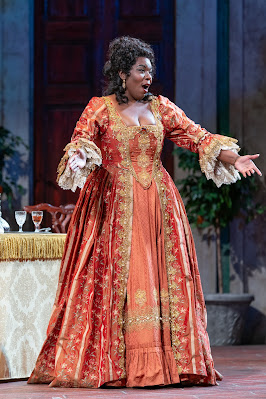 |
| Mozart: Le Nozze di Figaro – Michelle Johnson Sarasota Opera, 2025 (Photo: Robert Millington for Sarasota Opera) |
Conductor Louis Lohraseb brought a buoyant baton to this hum-along music, allowing room for orchestral playfulness and an assortment of lively complements to the action and performances. Sunlit blushes and reanimating ornamentations and flourishes “based on documents from the time of Mozart,” informs Lohraseb, were the conductor’s to impart on this orchestra, and to rank himself a competent Mozartian.
It is a true treat to hear a voice like Michelle Johnson’s in the role of the Countess. Lustrous and theatre-filling echoes were produced by this singer, and her care for a vocal line suits this music rightly. Johnson was well-partnered, theatrically and vocally, with the Susanna here, Virginia Mims. Ms. Mims has a dedicated following in Sarasota, justifiably so. Their one-time Studio Artist has developed into a splendid and resourceful singing-actor, the like that will be requested to adorn many stages.
Mattia Venni (Figaro) also paired well with Mims and Johnson. By decibel criterions, Venni can make sounds similar to those of Johnson. Venni knows where the opera buffa neighborhood is and found it regularly in this Nozze. He tossed off parole, paean, and portrayal with a degree of polish.
From what we have learnt about the composer and his childlike weltanschauung, Mozart was probably very empathetic of Cherubino. The Count’s page is battling the biological bowing of his adolescent system and how, by nature, the Countess consumes his every thought.
Lorenzo Da Ponte and Mozart put Cherubino at center of comedic corners, fertile grounds for buffa bounty. Sarasota Studio Artist Tessa Fackelmann trod well in this environment. Fackelmann’s neat “Voi che sapate” included phrases with some curious finishes tagged on, inducing the cutes for this character.
Eric Botto did some memorably funny work as Basilio, and as a judge with fitful fluency – a form of selective vocal paresis is my diagnosis. Further attending to the stage, there was much comic relief and slapstick that Mozart himself may have delighted in.
The entire production and setting (sets, scenes, and costumes, etc.) invoked images of those olden black and white motion pictures with opera scenes starring Ezio Pinza, the Marx Brothers, et al. The same is to be said of another opera in repertory, Il Barbiere di Siviglia, soon to be discussed.
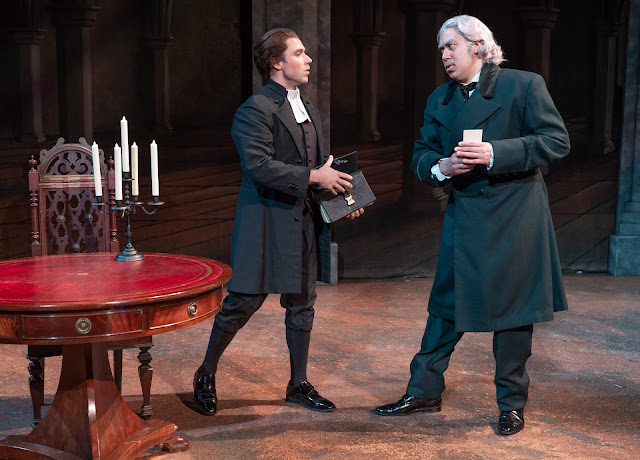 |
| Verdi: Stiffelio – Sarasota Opera, 2025(Photo: Robert Millington for Sarasota Opera) |
From at least the mid-twentieth century through to the present day, the Giuseppe Verdi opera Stiffelio appears on the world’s stages in diametrically converse numbers to those of Le nozze di Figaro. As a matter of detail, a researcher of critical editions of music scores, Kathleen Hansell, finds that Verdi’s original concept for Stiffelio only came complete to theatres in 1993. Hansell’s has become the prevailing point of view among Verdi specialists.
Stiffelio got on the radar then, when taken up by major theatres and the title role by established tenors. This doubtless gave the work more credulity and a stamp of authenticity as a Verdi opera. Now, Stiffelio has all the ingredients of a star vehicle for the leads.
You read that correctly, yes, leads. All three have pieces of the dramatic pole revolve around them in proportion; they occupy stage time and music comparably and each has their respective personal investments and raison d’etres as characters. Verdi has as much reason to have titled this work Lina or Stankar, as Stiffelio.
Tenor Victor Starsky continues to shine on stage, vocally. With every outing, Starsky lands on the auricle as the genuine article, and the music of Stiffelio a star vehicle for him. The role of Stiffelio as a whole is a work in progress. Psychodrama of this nature requires macerating, analysis and gradual integration. Get your tickets now if you can. Like Virginia Mims, Starsky has a strong following in Sarasota. He was received heartily at curtain.
Aviva Fortunata has her own reasons to find this opera a star-making turn as Lina. Fortunata sang with authority and ferocity; if there is something missing that makes for the hallmark features of a Verdi soprano, it went undetected. Fortunata has a mournful sob to her instrument that is special, unique and affixed to the color of her voice. In toto, this performer walks the stage in step with generations of star sopranos that came before her.
On the account of audience temperature, the Stankar of Ricardo Jose Rivera lifted this performance on an even plane to that of Stiffelio and Lina. Rivera furthermore lifted and flung his heavy baritone to all four corners of the theatre; his vocalizing was stentorian. The fine points put to it were rubato clips and collaborative equipoise between he and DeRenzi and instrumentalists. There was great weight to Stankar’s text and temperament. Rivera’s personification placed Stankar firmly in the position of Count of the Empire.
Remove much of the above, let the chorus stand alone, and you’d still recognize Verdi. Stiffelio could be credited to the chorus as much as the leads. It plays a major part in developing characters, in plotting the course of events, and in resolving theatrical themes. Arthur Bosarge (Chorus Master) and Victor DeRenzi (Artistic Director and Principal Conductor) worked in some smart meshing of voices to relate this music drama.
This production, created for this season’s Stiffelio, frames the action and supports the story well, with atmospheric highlights under the night lit cemetery of Act II and in the recognizable characteristics and mood of the interior of a church for the final scene.
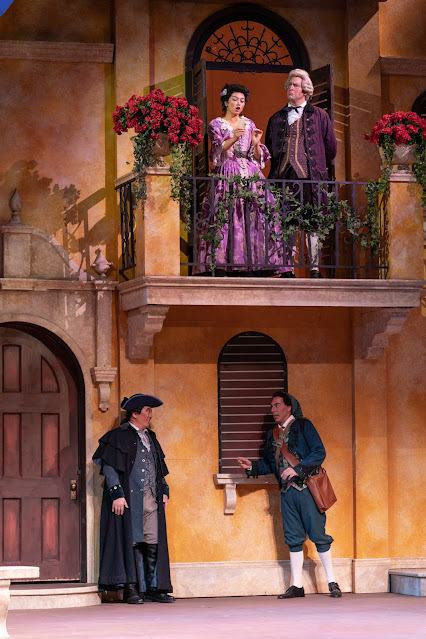 |
| Rossini: Il barbiere di Siviglia – Sarasota Opera, 2025(Photo: Robert Millington for Sarasota Opera) |
Il Barbiere di Siviglia places eighth on OPERABASE’s top ten list and was the second performed in cycle for the 2025 Winter Festival.
First appearing with Sarasota Opera in 2021, as Bertrando in Gioachino Rossini’s L’inganno felice, Christopher Bozeka steps in on short notice as Almaviva here to prodigious effect. In Bozeka we have a connoisseur’s singer and vocal stylist – following the line of the classic leggiero, but with something extra; there is more voice there, for Pinkerton and Rodolfo, Alfredo and il Duca.
If not altogether Italianate of voiceprint, Bozeka’s artfully sculpted singing has the hallmarks of the aristocratic tenor, in the tradition of Alfredo Kraus. What is more, Bozeka excels in getting messy, as one would need to in buffa. Thusly, Bozeka also brings much history to the stage, serving a grander purpose outside the scope of Sarasota’s Winter Festival and this Barbiere.
Interpolated high notes (one above high C), crafted lines with textually stressed sparkle – Bozeka makes Almaviva a show unto himself, and at the same time shares the spotlight giftedly and generously. His pairing with the Rosina of Lisa Marie Rogali was expert and effortless, a lucky and lovely meeting of sizes and timbres. That both these performers have fine dramatic taste, and comedic talent is just a bonus.
Filippo Fontana’s Figaro charmed at first sight but not altogether in ways you’d think. Fontana was either playing up Figaro’s nervous energy or settling down from a disarming case of performance anxiety; the performer began cautiously and seemed to ease into the goings-on as other characters entered and took their places in the story.
There were flickers of sparkle in Fontana’s Figaro to be sure, vocal charm, yes. There was a smile for his part in the duet about metallic (money) motivations and heart wishes. Fontana knows this music and worked his wordy lines smoothly through Bozeka’s extended phrasing. Nearing opera’s end, Fontana’s smiles were softer and more in number, putting a proper spin on “Zitti, zitti” with Rosina and Almaviva.
Mezzo-soprano Rogali can be every bit the soubrette redolent of Rossini for his Rosina, with humorous habits to complement Rossini’s music. Her vocal virtuosity was at full tilt when in duet with Bozeka.
The Bartolo of Andrew Gilstrap will go down among the best of the worst doctors and guardians of Rosinas witnessed by this writer. This Bartolo soaked in sly sarcasm, interchangeably taking off to another comedic cosmos and returning to planet earth absurdity, whatsoever befitted the byplay.
Conductor Marcello Cormio provided some of the most memorable musical moments of this five-opera set in Sarasota. This orchestra presents just as buoyantly for Cormio, and he presents just as bouyantly for Rossini, adding his own flashes of flair and fun. Cormio subtly handled tempi gradations and there were cheerful shadings from the strings and winds. As in Le Nozze, discussed before, the recitative accompaniment of the fortepiano was more than just a period garnish.
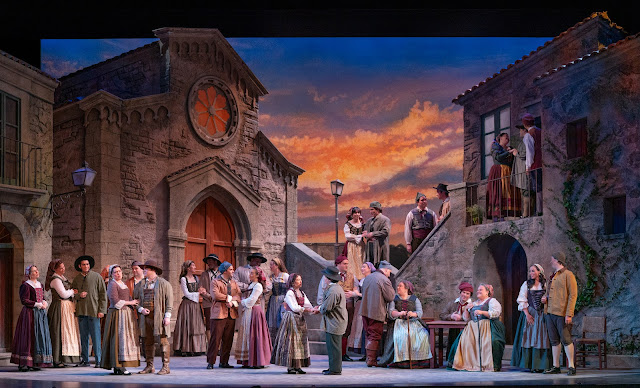 |
| Mascagni: Cavalleria Rusticana – Sarasota Opera, 2025(Photo: Robert Millington for Sarasota Opera) |
We need not reference sources to ascribe the scale of importance and prominence to Cavalleria Rusticana and Pagliacci as music dramas in the veristic tradition. It is no matter of wonder these were chosen to open the 2025 Winter Festival in Sarasota.
Sarasota Opera Artistic Director and Principal Conductor Victor DeRenzi paints inside the lines of Mascagni and Leoncavallo, musically spelling out how these works were besherted and hold dates on calendars wherever opera is performed. All that is leftover from DeRenzi’s approach is a gourmand’s appreciation for the morbidezza of these bulwarks of the Italian opera repertoire.
The very first notes of the prelude were marked by tight cohesion and a tender lift. The strings played with luster and the percussions with bite. The prelude, and later the Intermezzos of each opera, provided the kind of playing that tugs at the ear like a fond refrain to those becoming acquainted, and well after la commedia e finita. To those of us all too familiar with these, it has the same effect, to our great consternation.
Rafael Davila sang in heart-aching stride with the harp (Giuseppina Ciarla) and its forlorn strumming in the “Siciliana.” It might be considered a stroke of luxury casting to lure Davila away from international theatres but, you see, he is as a son returning from operatic triumph in Sarasota, having built an early career here as a regular visitor. Davila is the company’s David and Edith Chaifetz Endowed Artist for 2025.
Somewhat like Sarasota Opera, Davila seems to have made the necessary adjustments to expand on and prolong his performance profile. He retains a naturally appealing sound that this writer wishes to enjoy for many a day to come. The tenor is more measured, keeping this side of his voice’s center of gravity. In higher tessitura, this equals getting from note A to note B. Davila also knows just how much to give of himself dramatically.
With the more difficult and more emotional investments to come, Davila finished the Mascagni in professional form, saving himself for his view of Canio.
When Davila cultivates the lyricism in these roles, he achieves a level of performance that is quite winning. He was able to return to this kind of treatment all the way into “No, pagliaccio non son!” Turridu and Canio back-to-back is yeoman’s work for the most champion in this repertoire – Davila has this well in hand. Next stop, Andrea Chenier. Get your tickets now if you can.
Santuzza is a role that sits ideally in Lisa Chavez’s voice, and it is obvious she sympathizes with this character. Plush in tone, abetted by an appreciation for legato, clear transmission and articulation of text – Chavez is The Jan Schmidt Endowed Artist for Sarasota this season.
The savory surprise of the season may be baritone Jean Carlos Rodriguez. In complete opera form, Rodriguez’s voice has great presence, full and fetchingly resonant as it is.
Rodriguez holds the stage with authority – sufficiently as Alfio, quite. He held the stage pointedly plus as Tonio. He was a shallow and beaten creature, lecherous and loathsome to the audience; this stole any compassion it might have for him and swole any compassion it might have for Nedda, played by Ashley Milanese in this matinee show of Pagliacci.
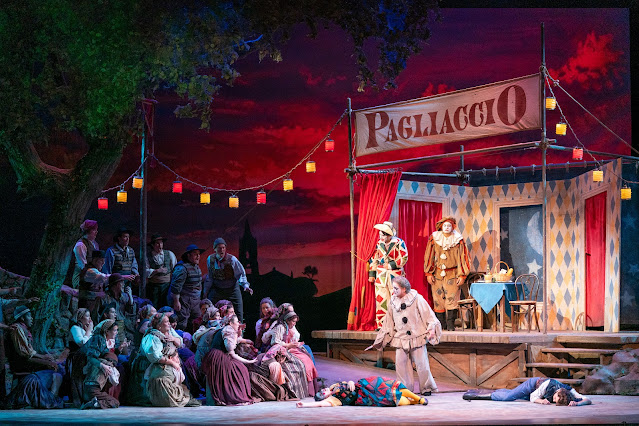 |
| Leoncavallo: Pagliacci – Sarasota Opera, 2025(Photo: Robert Millington for Sarasota Opera) |
There is enough in Ms. Milanese to forecast an operatic career filled with joyous adventures and warm audience responses, like the soprano soaked in now. The voice is on the main lyric. It is full and projects well, with a warm center and a tear whose origins serve up a wonderful bouquet invocative of her family name. Is that the Adriatic, the Mediterranean maybe? Milanese further uses her inherently communicative voice to full advantage, and she strikes a fetching figure on stage.
It is understandable that Nedda is so tempted as to put her entire clown troupe career on the line for the Silvio of Benjamin Dickerson. This baritone is a whole lot of man – tall, broad shouldered and as handsome and characterful of voice as of visage.
As Peppe, Alejandro Luevanos’ unusual tenor voice (he could be the next to replace Steve Perry in Journey) is a welcome bit of casting in one of opera’s most enigmatic roles. Anticipation grew – what would Luevanos do with Arlecchino’s ditty? This is a nice even sound with hardly a discernible register break.
Another aural balm feature of this season came in form of the choral work in Pagliacci. The musical minds in Sarasota joined with Leoncavallo’s to tribute the composer’s masterpiece of group singing. This was a glowing achievement in the matching and stationing of voices. The females were particularly profound in their telling of this tale.
What’s next for Sarasota Opera? “We work with the music for the music’s sake and never in a way that tries to find something that is not there.” In Victor DeRenzi’s conversation with Sarasota performers, this is but one of the encapsulations of the company’s operatic weltanschauung and what future seasons portend.
One thing certain to be a factor in “what’s next” is “what came before,” known to you also as history. Stewardship of the artform’s history is at the forefront of the artistic minds that meet at Sarasota Opera. One of those minds sits atop General Director Richard Russell: “We create as authentic an experience as we can, trying to do justice to the great works entrusted to us.”
 |
| Mozart: Le nozze di Figaro – Sarasota Opera, 2025(Photo: Robert Millington for Sarasota Opera) |
Tuesday March 25, 2025 at 7pm
Le nozze di Figaro
Wolfgang Amadeus Mozart, music
Lorenzo Da Ponte, text
2006 Sarasota Opera Production
Conductor: Louis Lohraseb
Chorus Master: Arthur Bosarge
Stage Director: Tom Diamond
Costume Designer: Howard Tsvi Kaplan
Lighting Designer: Ken Yunker
Set Designer: J. Michael Wingfield
Hair and Makeup Designer: Sue Schaefer
Assistant Conductors: Denis Uz, Curtis Serafin
Choreographer: Diane Partington
Surtitle Supplier: Words for Music
Surtitle Translator: Victor DeRenzi
Cast
Figaro: Mattia Venni
Susanna: Virginia Mims
Countess Almaviva: Michelle Johnson
Count Almaviva: Jake Stamatis
Cherubino: Tessa Fackelmann
Bartolo: Brian Kontes
Marcellina: Lauren Paul
Bartolo: Brian Kontes
Basilio: Eric Botto
Don Curzio: Eric Botto
Barbarina: Xochitl Hernandez
Antonio: Steven Broth
Wednesday March 26, 2025 at 7:30pm
Stiffelio
Giuseppe Verdi, music
Francesco Maria Piave, libretto
New Production
Conductor: Victor DeRenzi
Chorus Master: Arthur Bosarge
Stage Director: Stephanie Sundine
Costume Designer: Howard Tsvi Kaplan
Lighting Designer: Ken Yunker
Set Designer: Steven C. Kemp
Hair and Makeup Designer: Sue Schaefer
Assistant Conductors: Stefano Teani, Fabio Gentili, Chloe Jihee Kim
Fight Choreographer: India Marie Paul
Surtitle Supplier: Words for Music
Surtitle Translator: Victor DeRenzi
Cast
Stiffelio: Victor Starsky
Lina: Aviva Fortunata
Count Stankar: Ricardo José Rivera
Raffaele: Jeremy Brauner
Jorg: Young Bok Kim
Frederico di Frengel: Juan Hernandez
Thursday March 27, 2025 at 1:30pm
Il barbiere de Siviglia
Gioachino Rossini, music
Cesare Sterbini, poetry
2008 Sarasota Opera Production
Conductor: Marcello Cormio
Chorus Master: Arthur Bosarge
Stage Director: Marco Nistico
Scenic Designer: Jeffrey W. Dean
Costume Designer: Howard Tsvi Kaplan
Lighting Designer: Ken Yunker
Hair and Makeup Designer: Sue Schaefer
Assistant Conductors: Deniz Uz, Chloe Jihee Kim
Surtitle Supplier: Words for Music
Surtitle Translator: Victor DeRenzi
Cast
Count Almaviva: Christopher Bozeka
Don Bartolo: Andrew Gilstrap
Rosina: Lisa Marie Rogali
Figaro: Filippo Fontana
Don Basilio: Young Bok Kim
Berta: Alexandra Kzeski
Fiorello: John Potvin
Ambrogio: Collin Lahood
An official: Zeky Nadji
Saturday March 29, 2025 at 1:30pm
Cavalleria rusticana
Pietro Mascagni, music
Giovanni Targioni-Tozzetti and Guido Menasci, libretto
2005 Sarasota Opera Production
Conductor: Victor DeRenzi
Chorus Master: Arthur Bosarge
Stage Director: Martha Collins
Scenic Designer: David P. Gordon
Costume Designer: Howard Tsvi Kaplan
Lighting Designer: Ken Yunker
Hair and Makeup Designer: Sue Schaefer
Assistant Conductors: Stefano Teani, Fabio Gentili, Curtis Serafin
Surtitle Supplier: Words for Music
Surtitle Translator: Stephanie Sundine
Cast
Santuzza: Lisa Chavez
Turiddu: Rafael Dávila
Alfio: Jean Carlos Rodríguez
Pagliacci
Ruggero Leoncavallo, music and text
2005 Sarasota Opera Production
Conductor: Victor DeRenzi
Chorus Master: Arthur Bosarge
Youth Opera Chorus Master: Jesse Martins
Stage Director: Martha Collins
Scenic Designer: David P. Gordon
Costume Designer: Howard Tsvi Kaplan
Lighting Designer: Ken Yunker
Hair and Makeup Designer: Sue Schaefer
Assistant Conductors: Stefano Teani, Fabio Gentili, Curtis Serafin
Surtitle Supplier: Words for Music
Surtitle Translator: Stephanie Sundine
Cast
Nedda: Ashley Milanese
Canio: Rafaele Davila
Tonio: Jean Carlos Rodriguez
Peppe/Arlecchino: Alejandro Luevanos
Silvio: Benjamin Dickerson
Sarasota Opera began attracting international attention with
the Masterworks Revival Series, which presents neglected works of artistic
merit and made history in 2016 by completing the Verdi Cycle, a 28-season
effort to produce every work written by Giuseppe Verdi. Sarasota Opera is now
the only opera company in the world to have presented every work, in every
version and Maestro DeRenzi is the only conductor to have conducted all the
composer’s works. Sarasota is widely considered Verdi’s home in the United
States, and second only to the composer’s home in Busseto, Italy.
As destination-opera par
excellence, people from all corners of the world come for Sarasota Opera’s
Winter season, with its world-class productions that range from early Italian
Bel Canto to contemporary American opera. After the $20 million-dollar historic
renovation and restoration of a 1926 building in 2008, Sarasota Opera House has
been described as “a delightful 1000 seat art deco Opera House, whose acoustics
are superb (Opera magazine).”
The blog is free, but I’d be delighted if you were to show your appreciation by buying me a coffee.
Elsewhere on this blog
- An incredible feeling when you get it right; Martin Owen on performing Mozart’s complete horn concertos with Manchester Camerata – interview
- A somewhat eclectic yet satisfying journey: Swiss baritone Äneas Humm explores ideas of freedom in songs by Beethoven, Schubert, Amy Beach, and Joseph Marx – record review
- Remarkable intensity: powerful new 1980s-set Peter Grimes from Melly Still at Welsh National Opera with Nicky Spence – opera review
- Telling a musical story: violinist James Ehnes on the challenges of recording of Bach’s violin concertos with Canada’s NAC Orchestra – interview
- Powerful stuff: Ukrainian composer Boris Lyatoshynsky’s dramatic war-inspired symphony alongside Prokofiev’s Semyon Kotko – concert review
- Imagination & sense of drama: John Weldon’s 1701 prize-winning The Judgement of Paris in its first recording from Academy of Ancient Music & Cambridge Handel Opera Co – record review
- Up close and personal: David Butt Philip & Friends Gala at St Paul’s Opera, Clapham – opera review
- Pure enjoyment: Peter Moore & Tredegar Band give the first recording of Simon Dobson’s concerto for Moore – record review
- Bespoke Songs: soprano Fotina Naumenko on commissioning four composers for works for soprano and diverse ensembles – interview
- Richard Strauss at the Deutsche Oper Berlin:
- Elektra & Intermezzo – opera review
- Arabella with Jennifer Davis & Heidi Stober – opera review
- Home
